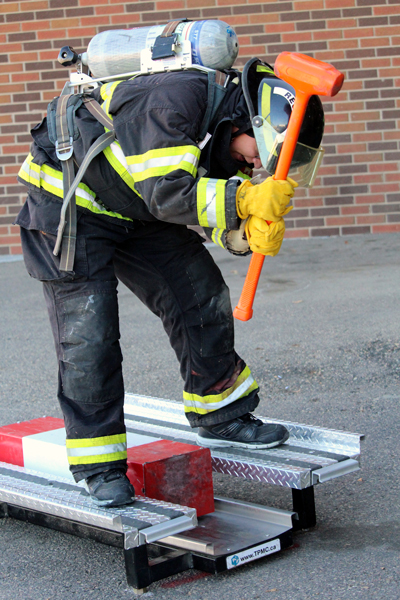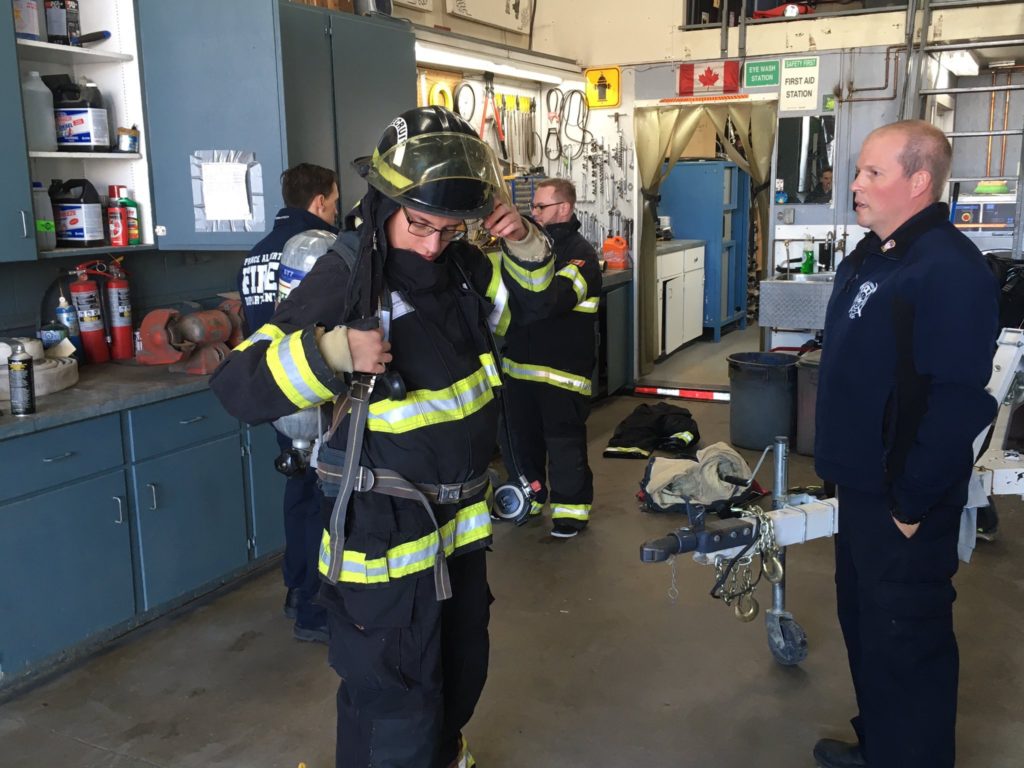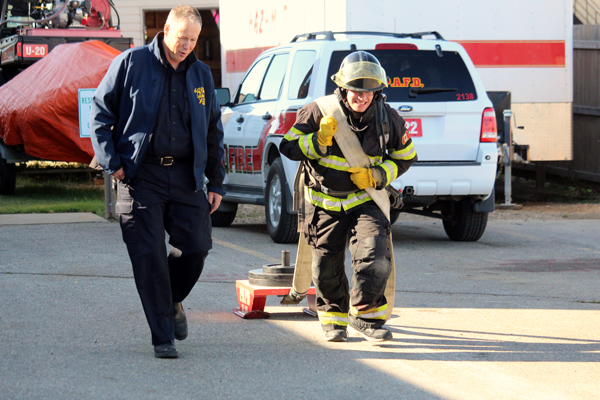
Halfway through my second trip up the flight of stairs, one thought went through my head: “What have I gotten myself into this time?.”
I was under no illusions that this would be easy, but I wasn’t ready for just how hard it would be. With laboured breathing, sweat beginning to collect under my black and yellow helmet, I continued to trudge up the stairs.
On my left shoulder was a 40-pound hose pack, on my back an air tank. Combined with the rest of the gear, that’s about an additional 80 pounds I was hauling up and down two flights of stairs. I had already climbed a ladder, lifted another and manoeuvred my way through a simple task while confined in a dark, wooden box.
Still, I was only halfway done.
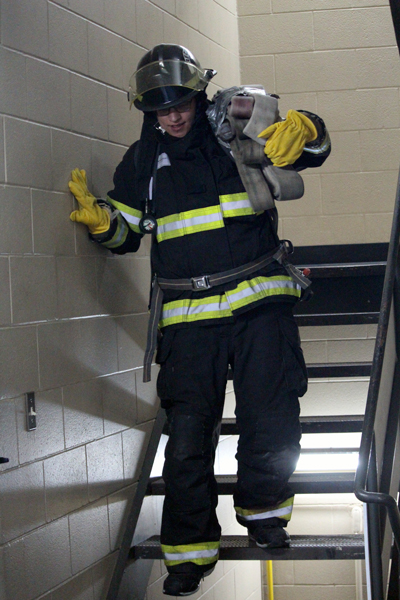
I was one of four members of the media who had agreed to subject themselves to this gruelling test put on by the Prince Albert Fire Department. Each of us had agreed to attempt part of the job-related performance testing the fire department puts all of its recruits through. Each task is designed to simulate a task you might face out in the field.
It starts with a confined space simulator. Fully geared up and breathing through the air mask, you get shut into a confined area, tasked with finding four washers in the dark, placing them on bolts and screwing the bolts into the holes located at each of the four corners of the top of the box.
It’s a nightmare for anyone who suffers from claustrophobia.
Next was the ladder lift. Still wearing full gear, each person is tasked with picking up a ladder and setting it on the ground, before replacing it on its brackets.
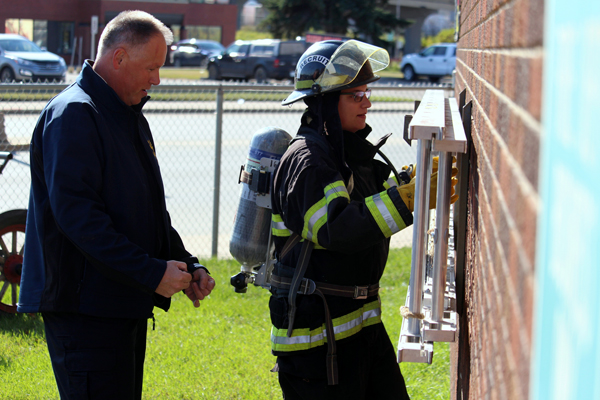
I failed at this task. I grabbed the ladder too low. While I got it about waist high, I couldn’t muster the upper body strength to lift it back onto the brackets. The other three all managed to complete the test.
Next was the ladder climb. My air tank was replaced with a harness and I was asked to climb the ladder to a height of 100 feet.
I got maybe 60 feet up before I looked down and my fear of heights kicked in.
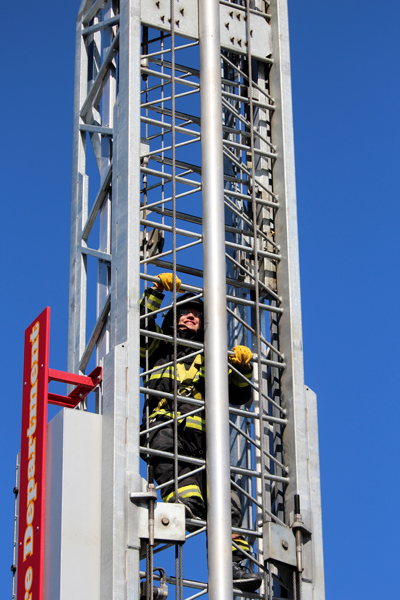
It was time to come down.
The other three contestants — radio hosts Andy Cohen and Lew Harrison and reporter Ronald Quaroni — made it to the top.
By now, though my legs were already burning, and my oft-injured wrists were screaming in pain. But I only made it halfway up the ladder once. Real recruits have to go all the way up and down twice.
Cue the stair climb.
Recruits get to do it thrice. Existing firefighters only need to complete it twice.
I made it up twice, but on the second time down, my shoulder was giving out. I threw the hose pack down halfway through my descent and took a second to catch my breath before trudging over to the rope pull.
Still fully geared up, I was to bend over the railing and pull a rope attached to a hose roll 75 feet. Several pulls later, and the hose skidded to a stop by my feet.
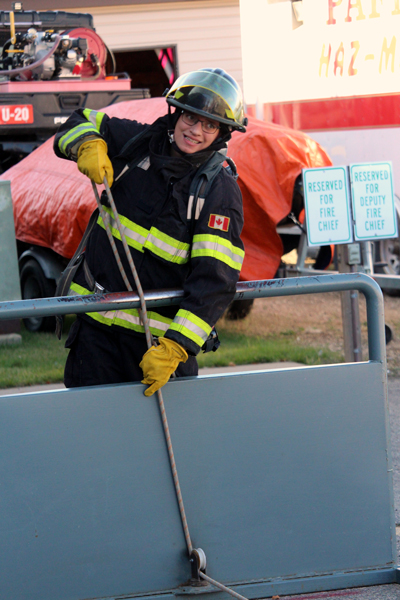
The next test also worked my upper body. A heavy metal sled sat on a track. I was to push it three feet with a sledgehammer. This was about technique, not just pure strength, meant to simulate a forced entry. Like the rope pull, I was successful.
Second-to-last was the hose drag. Again, a test of the lower body, while still fully geared up, we were to pull a 155lb load, simulating a charged-up hose, for a distance of 50 feet.
Once I got the sled going, it wasn’t too bad. With a little effort, I was able to drag the sled over the finish line.
Only one test was left, but I was feeling it. I was panting heavily and my mouth was dry.
I stumbled over to where a 175-pound mannequin was lying on the asphalt.
I was supposed to drag or carry him 50 feet while weaving in and out of traffic cones.
As soon as I went to pick him up, I knew I couldn’t manage. I staggered over to the back fence and slung my arms over the rail. My head was spinning, and I knew I was about to vomit.
The firefighters were right there, sitting me down onto a bucket and helping to remove some layers and hand me a water. As I cooled off in the parking lot, the feeling of impending sickness vanished and my heartbeat and body temperature began to return to normal levels.
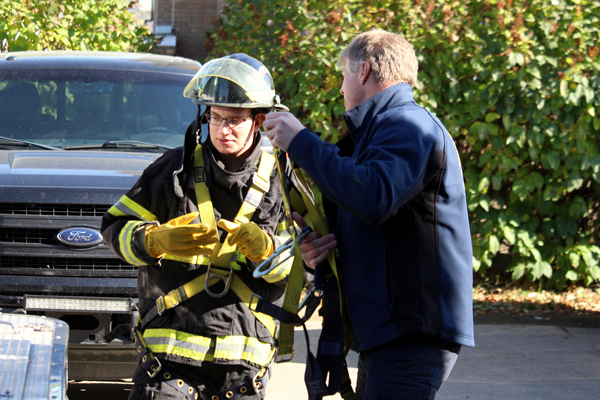
I have a new appreciation for what firefighters do and what they’re capable of.
It wasn’t my first time in full gear — back in Alberta, I was lucky enough to get the opportunity to train with a local volunteer detachment once a week for several months before being tasked with extinguishing a small fire in their training facility.
But that was four years ago and didn’t require a whole string of performance and fitness tests back to back.
Recruits do those tests after swimming six full-lengths of a 75-foot pool in the morning. Those at the top of their game complete everything from the stair climb on in three and a half to four minutes.
I’m not the fittest person — I have what I affectionately call “desk gut” from too many hours sitting in the office and too many trips to A&W. But I’m not in horrible shape either. There might be more of me to love than I wish there was, but there are definitely people worse off than me.
The experience gave me a much greater appreciation for what firefighters do and what they’re prepared for, and that’s not even counting their willingness to run towards fire when we flee in the opposite direction, or their daily work caring for people and cleaning up at crash sites and medical emergencies. It’s taxing on the mind and on the body.

Take the time to thank a firefighter next time you see one. It’s impressive what they’re able to do, and it’s imperative that they’re there to keep us safe.
Or, better yet, stop by their fire prevention open house this Sunday from 10 a.m. to 2 p.m. and see some of what they do for yourself.
Even better, during fire prevention week next week, take the time to review your own fire safety plan and practice your escape to ensure that should you encounter a fire, you’re prepared.
